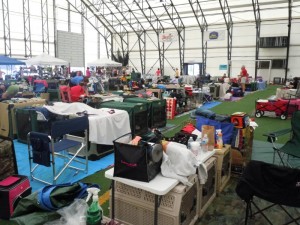
Trial environments are very stressful and for a majority of competing dogs, only appear a few times a year. Some trials may have from just a few people and dogs to a few hundred. Crating space is often limited and cramped. Not to mention, there are many novel objects and noises that most dogs will not encounter in their training. One must also consider the added stress from the handler. On competition day, handlers are typically nervous particularly at the novice or high level events. The handlers breathing, movements and cues are all different on event day and this will project onto the dog (Susan Garrett,
2012). As the dog gains experience with the trial routine, the dog will figure out all those handler related stress cues result in performing that day with zero reinforcement during the exercise, which will dilute the effectiveness of the performance cues (Susan Garrett, 2012).
Stress may manifest in a variety of ways (Fenzi & Jones, 2013):
- Tension in the head and body
- Ears tucked
- Yawning
- Lip Licking
- Frantic, repetitive movement, unable to settle
- Body Shake
- Clinging
- “Zoomies” – Sudden frantic running around the ring, often ignoring the handlers cues and avoiding humans
- Vocalization – some agility dogs may bark excessively during their run
- Sniffing while in the ring
- Looking away, avoiding handler eye contact
- Overall poor performance
Take a look at this novice obedience run and look for some of these things.